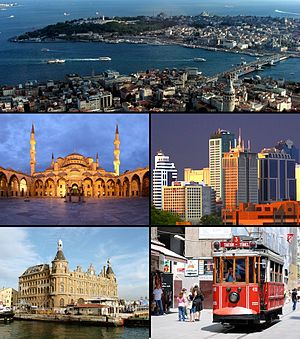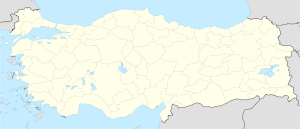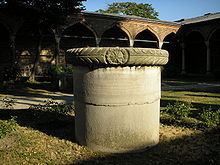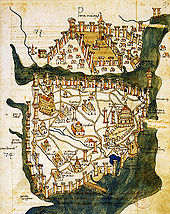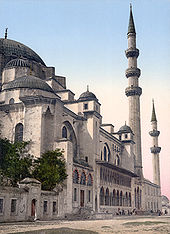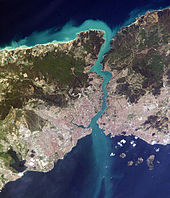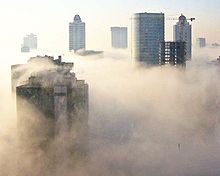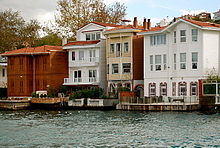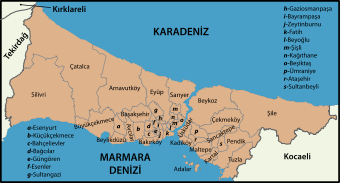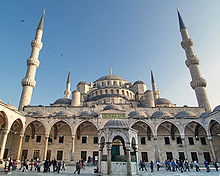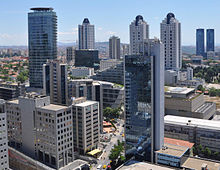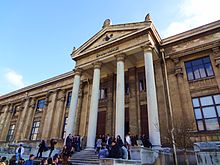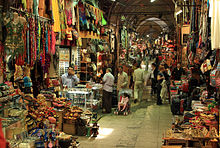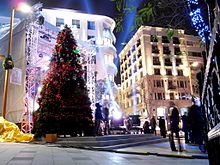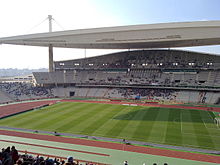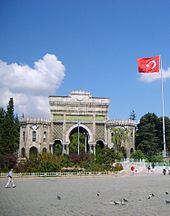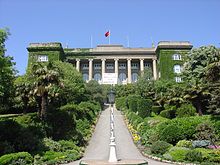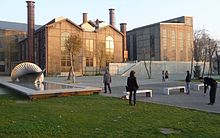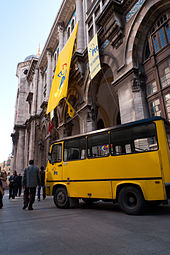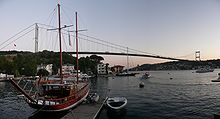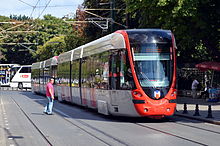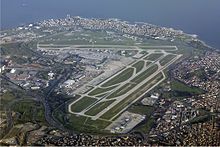
Istanbul
Did you know...
This wikipedia selection has been chosen by volunteers helping SOS Children from Wikipedia for this Wikipedia Selection for schools. Click here to find out about child sponsorship.
| Istanbul İstanbul |
|
|---|---|
| — Metropolitan municipality — | |
| Clockwise from top: The Golden Horn between Galata and the Seraglio Point; Maslak financial district; İstiklal Avenue; Haydarpaşa Terminal; and Sultan Ahmed Mosque | |
|
|
|
| Coordinates: 41°00′49″N 28°57′18″E | |
| Country | Turkey |
| Region | Marmara |
| Province | Istanbul |
| Established | |
| - Byzantium | c. 660 BC |
| - Constantinople | 330 AD |
| - Istanbul | 1930 (officially) |
| Districts | 39 |
| Government | |
| • Mayor | Kadir Topbaş ( AKP) |
| Area | |
| • Metro | 5,343 km2 (2,063 sq mi) |
| Population (2012) | |
| • Metropolitan municipality | 13,854,740 |
| • Density | 2,593/km2 (6,720/sq mi) |
| Demonym | Istanbulite(s) (Turkish: İstanbullu(lar)) |
| Time zone | EET ( UTC+2) |
| • Summer ( DST) | EEST ( UTC+3) |
| Postal code | 34000 to 34850 |
| Area code(s) | (+90) 212 (European side) (+90) 216 (Asian side) |
| Website | Istanbul Metropolitan Municipality |
Istanbul ( Turkish: İstanbul) is the largest city in Turkey, constituting the country's economic, cultural, and historical heart. With a population of 13.9 million, the city forms one of the largest urban agglomerations in Europe and is among the largest cities in the world by population within city limits. Istanbul's vast area of 5,343 square kilometers (2,063 sq mi) is coterminous with Istanbul Province, of which the city is the administrative capital. Istanbul is a transcontinental city, straddling the Bosphorus—one of the world's busiest waterways—in northwestern Turkey, between the Sea of Marmara and the Black Sea. Its commercial and historical centre lies in Europe, while a third of its population lives in Asia.
Founded on the Sarayburnu promontory around 660 BC as Byzantium, the city now known as Istanbul developed to become one of the most significant cities in history. For nearly sixteen centuries following its reestablishment as Constantinople in 330 AD, it served as the capital of four empires: the Roman Empire (330–395), the Byzantine Empire (395–1204 and 1261–1453), the Latin Empire (1204–1261), and the Ottoman Empire (1453–1922). It was instrumental in the advancement of Christianity during Roman and Byzantine times, before the Ottomans conquered the city in 1453 and transformed it into an Islamic stronghold and the seat of the last caliphate. Although the Republic of Turkey established its capital in Ankara, palaces and imperial mosques still line Istanbul's hills as visible reminders of the city's previous central role.
Istanbul's strategic position along the historic Silk Road, rail networks to Europe and the Middle East, and the only sea route between the Black Sea and the Mediterranean have helped foster an eclectic populace, although less so since the establishment of the Republic in 1923. Overlooked for the new capital during the interwar period, the city has since regained much of its prominence. The population of the city has increased tenfold since the 1950s, as migrants from across Anatolia have flocked to the metropolis and city limits have expanded to accommodate them. Arts festivals were established at the end of the 20th century, while infrastructure improvements have produced a complex transportation network.
Seven million foreign visitors arrived in Istanbul in 2010, when it was named a European Capital of Culture, making the city the world's tenth-most-popular tourist destination. The city's biggest draw remains its historic centre, partially listed as a UNESCO World Heritage Site, but its cultural and entertainment hub can be found across the city's natural harbour, the Golden Horn, in the Beyoğlu district. Considered a global city, Istanbul hosts the headquarters of many Turkish companies and media outlets and accounts for more than a quarter of the country's gross domestic product. Hoping to capitalize on its revitalization and rapid expansion, Istanbul is currently bidding for the 2020 Summer Olympics.
Toponymy
The first known name of the city is Byzantium (Greek: Βυζάντιον, Byzántion), originating from the name of the king, Byzas, whose colony founded it around 660 BC. After Constantine the Great made it the new eastern capital of the Roman Empire in 330 AD, the city became widely known as Constantinopolis (Constantinople), which, as the Latinized form of "Κωνσταντινούπολις" (Konstantinoúpolis), means the "City of Constantine". He also attempted to promote the name Nea Roma ("New Rome"), but this did not attain widespread usage. Constantinople remained the most common name for the city in the West until the establishment of the Turkish Republic, and Kostantiniyye ( Ottoman Turkish قسطنطينيه) was the primary name used by the Ottomans during their rule. Nevertheless, the use of Constantinople to refer to the city during the Ottoman period (from the mid-15th century) is now considered politically incorrect, even if not historically inaccurate, by Turks.
By the 19th century, the city had acquired a number of other names used by either foreigners or Turks. Europeans used Constantinople to refer to the whole of the city, but used the name Stamboul—as the Turks also did—to describe the walled peninsula between the Golden Horn and the Sea of Marmara. Pera (from the Greek word for "across") was used to describe the area between the Golden Horn and the Bosphorus, but Turks also used the name Beyoğlu, which is still in use today. Islambol (meaning either "City of Islam" or "Full of Islam") was sometimes colloquially used to refer to the city, and was even engraved on some Ottoman coins, but the belief that it was the precursor to the present name, İstanbul, is belied by the fact that the latter existed well before the former and even predates the Ottoman and Muslim conquest of the city.
Etymologically, the name İstanbul (Turkish pronunciation: [isˈtanbuɫ], colloquially [ɯsˈtambuɫ]) derives from the Medieval Greek phrase "εἰς τὴν Πόλιν" (pronounced [is tin ˈpolin]), which means "to the city". This reflected its status as the only major city in the vicinity, much in the same way people today often colloquially refer to their nearby urban centers as "the City". An alternative view is that the name evolved directly from the name Constantinople, with the first and third syllables dropped. In modern Turkish, the name is written as İstanbul, with a dotted İ, as the Turkish alphabet distinguishes between a dotted and dotless I. Also, while in English the stress is on the first syllable (Is), in Turkish it is on the second syllable (tan). İstanbul was officially adopted as the sole name of the city in 1930. A person from the city is an İstanbullu (plural: İstanbullular), although Istanbulite is used in English.
History
Neolithic artifacts, dating back to the 7th millennium BC and uncovered by archaeologists at the beginning of the 21st century AD, indicate Istanbul's historic peninsula was settled earlier than previously thought and before the Bosphorus was even formed. Before the discovery, conventional wisdom held that Thracian tribes, including the Phrygians, began settling on the Sarayburnu in the late 6th millennium BC. On the Asian side, artifacts originating around the 4th millennium BC have been found in Fikirtepe (within Kadıköy). The same location was the site of a Phoenician trading post at the beginning of the 1st millennium BC as well as the town of Chalcedon, which was established in c. 680 BC.
However, the history of Istanbul generally begins around 660 BC, when settlers from Megara, under the command of King Byzas, established Byzantium on the European side of the Bosphorus. The settlers proceeded to build an acropolis adjacent to the Golden Horn on the site of the early Thracian settlements, fueling the nascent city's economy. The city experienced a brief period of Persian rule at the turn of the 5th century BC, but the Greeks recaptured it during the Greco-Persian Wars. Byzantium then continued as part of the Athenian League and its successor, the Second Athenian Empire, before ultimately gaining independence in 355 BC. Long allied with the Romans, Byzantium officially became a part of the Roman Empire in 73 AD.
Byzantium's decision to side with the usurper Pescennius Niger against Roman Emperor Septimius Severus cost it dearly; by the time it surrendered at the end of 195 AD, two years of siege had left the city devastated. Still, five years later, Severus began to rebuild Byzantium, and the city regained—and, by some accounts, surpassed—its previous prosperity.
Rise and fall of Constantinople
Constantine the Great effectively became the emperor of the whole of the Roman Empire in September 324. Two months later, Constantine laid out the plans for a new, Christian city to replace Byzantium. As the eastern capital of the empire, the city was named Nea Roma; however, most simply called it Constantinople, a name that persisted into the 20th century. Six years later, on 11 May 330, Constantinople was proclaimed the capital of an empire that eventually became known as the Byzantine Empire or Eastern Roman Empire.
The establishment of Constantinople served as one of Constantine's most lasting accomplishments, shifting Roman power eastward as the city became a centre of Greek culture and Christianity. Numerous churches were built across the city, including the Hagia Sophia, which remained the world's largest cathedral for a thousand years. Other improvements to the city undertaken by Constantine included a major renovation and expansion of the Hippodrome of Constantinople; accommodating tens of thousands of spectators, the hippodrome became central to civic life and, in the 5th and 6th centuries, the epicenter of episodes of unrest, including the Nika riots. Constantinople's location also ensured its existence would stand the test of time; for many centuries, its walls and seafront protected Europe against invaders from the east and the advance of Islam. During most of the Middle Ages, the latter part of the Byzantine era, Constantinople was the largest and wealthiest city on the European continent and at times the largest in the world.
Constantinople began to decline after the Fourth Crusade, during which it was sacked and pillaged. The city subsequently became the centre of the Latin Empire, created by Catholic crusaders to replace the Orthodox Byzantine Empire. However, the Latin Empire was short-lived, and the Byzantine Empire was restored, albeit weakened, in 1261. Constantinople's churches, defenses, and basic services were in disrepair, and its population had dwindled to a hundred thousand from up to half a million during the 8th century.
Various economic and military policies instituted by Andronikos II, such as the reduction of military forces, weakened the empire and left it more vulnerable to attack. In the mid-14th century, the Ottoman Turks began a strategy of taking smaller towns and cities over time, cutting off Constantinople's supply routes and strangling it slowly. Finally, on 29 May 1453, after an eight-week siege (during which the last Roman emperor, Constantine XI, was killed), Sultan Mehmed II "the Conqueror" captured Constantinople and declared it the new capital of the Ottoman Empire. Hours later, the sultan rode to the Hagia Sophia and summoned an imam to proclaim the Islamic creed, converting the grand cathedral into an imperial mosque.
Ottoman and Turkish era
Following the fall of Constantinople, Mehmed II immediately set out to revitalize the city, by then also known as Istanbul. He urged the return of those who had fled the city during the siege, and forcibly resettled Muslims, Jews, and Christians from other parts of Anatolia. The sultan invited people from all over Europe to his capital, creating a cosmopolitan society that persisted through much of the Ottoman period. Meanwhile, Mehmed II repaired the city's damaged infrastructure, began to build the Grand Bazaar, and constructed Topkapı Palace, the sultan's official residence.
The Ottomans quickly transformed the city from a bastion of Christianity to a symbol of Islamic culture. Religious foundations were established to fund the construction of grand imperial mosques, often adjoined by schools, hospitals, and public baths. The Ottoman Dynasty claimed the status of caliphate in 1517, with Istanbul remaining the capital of this last caliphate for four centuries. Suleiman the Magnificent's reign from 1520 to 1566 was a period of especially great artistic and architectural achievement; chief architect Mimar Sinan designed several iconic buildings in the city, while Ottoman arts of ceramics, calligraphy, and miniature flourished. The total population of Istanbul amounted to 570,000 by the end of the 18th century.
A period of rebellion at the start of the 19th century led to the rise of the progressive Sultan Mahmud II and eventually to the Tanzimat period, which produced political reforms and allowed new technology to be introduced to the city. Bridges across the Golden Horn were constructed during this period, and Istanbul was connected to the rest of the European railway network in the 1880s. Modern facilities, such as a stable water network, electricity, telephones, and trams, were gradually introduced to Istanbul over the following decades, although later than to other European cities. Still, the modernization efforts were not enough to forestall the decline of the Ottoman Empire.
In the early 20th century, the Young Turk Revolution disposed of Sultan Abdul Hamid II and a series of wars plagued the ailing empire's capital. The last of these, World War I, resulted in the British, French, and Italian occupation of Istanbul. The final Ottoman sultan, Mehmed VI, was exiled in November 1922; the following year, the occupation of Istanbul ended with the signing of the Treaty of Lausanne and the recognition of the Republic of Turkey, declared by Mustafa Kemal Atatürk.
In the early years of the republic, Istanbul was overlooked in favour of Ankara, selected as Turkey's capital to distance the new, secular country from its Ottoman history. However, starting from the late 1940s and early 1950s, Istanbul underwent great structural change, as new public squares, boulevards, and avenues were constructed throughout the city, sometimes at the expense of historical buildings. The population of Istanbul began to rapidly increase in the 1970s, as people from Anatolia migrated to the city to find employment in the many new factories that were built on the outskirts of the sprawling metropolis. This sudden, sharp rise in the city's population caused a large demand for housing development, and many previously outlying villages and forests became engulfed into the metropolitan area of Istanbul.
Geography
Istanbul is located in northwestern Turkey within the Marmara Region on a total area of 5,343 square kilometers (2,063 sq mi). The Bosphorus, which connects the Sea of Marmara to the Black Sea, divides the city into a European, Thracian side—comprising the historic and economic centers—and an Asian, Anatolian side. The city is further divided by the Golden Horn, a natural harbour bounding the peninsula where the former Byzantium and Constantinople were founded. The confluence of the Sea of Marmara, the Bosphorus, and the Golden Horn at the heart of present-day Istanbul has deterred attacking forces for thousands of years and still remains a prominent feature of the city's landscape.
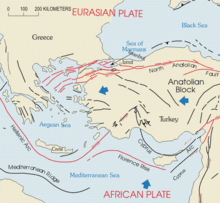
Following the model of Rome, the historic peninsula is said to be characterized by seven hills, each topped by imperial mosques. The easternmost of these hills is the site of Topkapı Palace on the Sarayburnu. Rising from the opposite side of the Golden Horn is another, conical hill, where the modern Beyoğlu district is situated. Because of the topography, buildings in Beyoğlu were once constructed with the help of terraced retaining walls, and roads were laid out in the form of steps. Üsküdar on the Asian side exhibits similarly hilly characteristics, with the terrain gradually extending down to the Bosphorus coast, but the landscape in Şemsipaşa and Ayazma is more abrupt, akin to a promontory. The highest point in Istanbul is Çamlıca Hill, with an altitude of 288 meters (945 ft).
Istanbul is situated near the North Anatolian Fault, close to the boundary between the African and Eurasian Plates. This fault zone, which runs from northern Anatolia to the Sea of Marmara, has been responsible for several deadly earthquakes throughout the city's history. Among the most devastating of these seismic events was the 1509 earthquake, which caused a tsunami that broke over the walls of the city and killed more than 10,000 people. More recently, in 1999, an earthquake with its epicenter in nearby İzmit left 18,000 people dead, including 1,000 people in Istanbul's suburbs. The people of Istanbul remain concerned that an even more catastrophic seismic event may be in the city's near future, as thousands of structures recently built to accommodate Istanbul's rapidly increasing population may not have been constructed properly. Seismologists say the risk of a 7.6- magnitude or greater earthquake striking Istanbul by 2030 is more than 60 percent.
Climate
According to the updated Köppen–Geiger classification system, Istanbul has a borderline Mediterranean climate (Csa) and humid subtropical climate (Cfa); since it has only two summer months with less than 40 millimeters (1.6 in) of rainfall, the city cannot be classified as solely Mediterranean or humid subtropical. Due to its vast size, diverse topography, and maritime location, Istanbul exhibits microclimates. Northern parts of the city express characteristics of an oceanic climate because of humidity from the Black Sea and the relatively high concentration of vegetation. The climate in the populated areas of the city in the south is warmer and less affected by humidity.
Indeed, one of the most salient characteristics of the climate in parts of Istanbul is its persistently high humidity, which reaches 80 percent most mornings. Because of these conditions, fog is very common, although more so in northern parts of the city and away from the city centre. Notably dense fog events that disrupt transportation in the region, including on the Bosphorus, are perennial occurrences during the autumn and winter months, when the humidity remains high into the afternoon. The humid conditions and the fog tend to dissipate by midday during the summer months, but the lingering humidity still has the effect of exacerbating the moderately high summer temperatures. During these summer months, high temperatures average around 29 °C (84 °F) and rainfall is uncommon; there are only about fifteen days with measurable precipitation between June and August. Nevertheless, despite the low precipitation, the summer months also have the highest concentration of thunderstorms.
Winter is colder in Istanbul than in most other cities around the Mediterranean Basin, with low temperatures averaging 4–5 °C (39–41 °F). Lake-effect snow from the Black Sea is common, although difficult to forecast, with the potential to be heavy and—as with the fog—disruptive to the city's infrastructure. Spring and autumn are mild, but often wet and unpredictable; chilly winds from the northwest and warm gusts from the south—sometimes in the same day—tend to cause fluctuations in temperature. Overall, Istanbul has an annual average of 115 days with significant precipitation, which amounts to 852 millimeters (33.5 in) per year. The highest and lowest temperatures ever recorded in the city are 40.5 °C (105 °F) and −16.1 °C (3 °F), respectively. The highest amount of rainfall recorded in a single day is 227 millimeters (8.9 in), whereas the highest recorded snow cover is 80 centimeters (31 in).
| Climate data for Istanbul (1970–2011) | |||||||||||||
|---|---|---|---|---|---|---|---|---|---|---|---|---|---|
| Month | Jan | Feb | Mar | Apr | May | Jun | Jul | Aug | Sep | Oct | Nov | Dec | Year |
| Average high °C (°F) | 9.3 (48.7) |
9.7 (49.5) |
12.1 (53.8) |
17.0 (62.6) |
22.1 (71.8) |
26.9 (80.4) |
29.4 (84.9) |
29.2 (84.6) |
25.5 (77.9) |
20.2 (68.4) |
15.2 (59.4) |
11.2 (52.2) |
18.98 (66.18) |
| Average low °C (°F) | 4.2 (39.6) |
4.0 (39.2) |
5.5 (41.9) |
9.3 (48.7) |
13.5 (56.3) |
18.0 (64.4) |
20.4 (68.7) |
20.5 (68.9) |
17.4 (63.3) |
13.6 (56.5) |
9.3 (48.7) |
6.2 (43.2) |
11.83 (53.28) |
| Precipitation mm (inches) | 100.9 (3.972) |
80.9 (3.185) |
69.6 (2.74) |
45.4 (1.787) |
35.5 (1.398) |
37.5 (1.476) |
39.0 (1.535) |
46.3 (1.823) |
62.9 (2.476) |
100.7 (3.965) |
108.6 (4.276) |
124.7 (4.909) |
852 (33.542) |
| Avg. precipitation days (≥ 0.1 mm) | 15.6 | 14.2 | 11.8 | 10.7 | 7.3 | 5.4 | 3.7 | 4.0 | 5.6 | 10.2 | 11.2 | 15.4 | 115.1 |
| Mean monthly sunshine hours | 68.2 | 87.6 | 133.3 | 180.0 | 251.1 | 285.0 | 319.3 | 288.3 | 228.0 | 158.1 | 99.0 | 68.2 | 2,166.1 |
| Source: Turkish State Meteorological Service (all exc. rain data: 1970–2011; rain data: 1970–2010) | |||||||||||||
Cityscape
| Historic Areas of Istanbul | |
|---|---|
| Name as inscribed on the World Heritage List | |
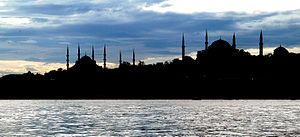 |
|
| Country | Turkey |
| Type | Cultural |
| Criteria | I, II, III, IV |
| Reference | 356 |
| UNESCO region | Europe and North America |
| Inscription history | |
| Inscription | 1985 (9th Session) |
The Fatih district corresponds to what was, until the Ottoman conquest, the whole of the city, across from which stood the Genoese citadel of Galata. Those Genoese fortifications were largely demolished in the 19th century, leaving only the Galata Tower, to make way for northward expansion of the city. Galata is now a part of the Beyoğlu district, which forms Istanbul's commercial and entertainment centre around Taksim Square.
Dolmabahçe Palace, the seat of government during the late Ottoman period, is located in Beşiktaş, just north of Beyoğlu, across from BJK İnönü Stadium, home to Turkey's oldest sports club. The former village of Ortaköy is situated within Beşiktaş and provides its name to the Ortaköy Mosque, along the Bosphorus near the First Bosphorus Bridge. Lining the shores of the Bosphorus north of there are yalıs, luxurious chalet mansions originally built by 19th-century aristocrats and elites as summer homes. Farther inland, outside the city's inner ring road, are Levent and Maslak, Istanbul's primary economic centers.
During the Ottoman period, Üsküdar and Kadıköy were outside the scope of urban Istanbul, serving as tranquil outposts with seaside yalıs and gardens. However, during the second half of the 20th century, the Asian side experienced massive urban growth; the late development of this part of the city led to better infrastructure and tidier urban planning when compared with most other residential areas in the city. Much of the Asian side of the Bosphorus functions as a suburb of the economic and commercial centers in European Istanbul, accounting for a third of the city's population but only a quarter of its employment. As a result of Istanbul's exponential growth during the 20th century, a significant portion of the city is composed of gecekondular (literally "built overnight"), referring to illegally constructed squatter buildings. At present, some gecekondu areas are being gradually demolished and replaced by modern mass-housing compounds.
Istanbul does not have a primary urban park, unlike other large cities, but it does have a number of green areas. Gülhane Park and Yıldız Park were originally included within the grounds of two of Istanbul's palaces—Topkapı Palace and Yıldız Palace—but they were repurposed as public parks in the early decades of the Turkish Republic. Another park, Fethi Paşa Korusu, is situated on a hillside adjacent to the Bosphorus Bridge in Anatolia, opposite Yıldız Palace. Along the European side, and closer to the Fatih Sultan Mehmet Bridge, is Emirgan Park; originally a private estate belonging to Ottoman leaders, the 47-hectare (120-acre) park is known for its diversity of plants and an annual tulip festival held since 2005. Popular during the summer among Istanbulites is Belgrad Forest, spreading across 5,500 hectares (14,000 acres) at the northern edge of the city. The forest originally supplied water to the city and remnants of reservoirs used during Byzantine and Ottoman times still survive.
Architecture
Istanbul is primarily known for its Byzantine and Ottoman architecture, but its buildings reflect the various peoples and empires that have previously ruled the city. Examples of Genoese and Roman architecture remain visible in Istanbul alongside their Ottoman counterparts. While nothing of the architecture of the classical Greek period has survived, Roman architecture has proved to be more durable. Obelisks from the Hippodrome of Constantinople are still visible in Sultanahmet Square, while a section of the Valens Aqueduct, constructed in the late 4th century, stands relatively intact at the western edge of the Fatih district. The Column of Constantine, erected in 330 AD to mark the new Roman capital, still stands not far from the Hippodrome.
Early Byzantine architecture followed the classical Roman model of domes and arches, but improved upon these elements, as in the Church of the Saints Sergius and Bacchus. The oldest surviving Byzantine church in Istanbul—albeit in ruins—is the Monastery of Stoudios (later converted into the Imrahor Mosque), which was built in 454. After the recapture of Constantinople in 1261, the Byzantines enlarged two of the most important churches still extant, Chora Church and Pammakaristos Church. Still, the pinnacle of Byzantine architecture, and one of Istanbul's most iconic structures, is the Hagia Sophia. Topped by a dome 31 meters (102 ft) in diameter, the Hagia Sophia stood as the world's largest cathedral for more than a thousand years, before being converted into a mosque and, as it stands now, a museum.
Among the oldest surviving examples of Ottoman architecture in Istanbul are the Anadoluhisarı and Rumelihisarı fortresses, which assisted the Ottomans during their siege of the city. Over the next four centuries, the Ottomans proceeded to make an indelible impression on the skyline of Istanbul, building towering mosques and ornate palaces. The largest palace, Topkapı, includes a diverse array of architectural styles, from Baroque inside the Harem, to its Neoclassical style Enderûn Library. The imperial mosques include Sultan Ahmed Mosque (the Blue Mosque), Süleymaniye Mosque, and Yeni Mosque, all of which were built at the peak of the Ottoman Empire, in the 16th and 17th centuries. In the following centuries, and especially after the Tanzimat reforms, Ottoman architecture was supplanted by European styles. Areas around İstiklal Avenue were filled with grand European embassies and rows of buildings in Neoclassical, Renaissance Revival and Art Nouveau styles, which went on to influence the architecture of a variety of structures in Beyoğlu—including churches, stores, and theaters—and official buildings such as Dolmabahçe Palace.
Administration
Since 2004, Istanbul has been one of only two cities in Turkey (the other being İzmit) whose city boundaries are concurrent with the boundaries of its province. The city, considered capital of Istanbul Province, is administered by the Istanbul Metropolitan Municipality (MMI), which oversees the thirty-nine districts of the city-province.
The current city structure can be traced back to the Tanzimat period of reform in the 19th century, before which Islamic judges and imams led the city under the auspices of the Grand Vizier. Following the model of French cities, this religious system was replaced by a mayor and a citywide council composed of representatives of the confessional groups ( millet) across Istanbul. Beyoğlu was the first area of the city to have its own director and council, with members instead being longtime residents of the neighbourhood. Laws enacted after the Ottoman constitution of 1876 aimed to expand this structure across the city, imitating the twenty arrondissements of Paris, but they were not fully implemented until 1908, when Istanbul was declared a province with nine constituent districts. This system continued beyond the founding of the Turkish Republic, with the province renamed a belediye (municipality), but the municipality was disbanded in 1957.
Small settlements adjacent to major population centers in Turkey, including Istanbul, were merged into their respective primary cities during the early 1980s, resulting in metropolitan municipalities. The main decision-making body of the Istanbul Metropolitan Municipality is the Municipal Council, with members drawn from district councils. The Municipal Council is responsible for citywide issues, including managing the budget, maintaining civic infrastructure, and overseeing museums and major cultural centers. Since the government operates under a "powerful mayor, weak council" approach, the council's leader—the metropolitan mayor—has the authority to make swift decisions, often at the expense of transparency. The Municipal Council is advised by the Metropolitan Executive Committee, although the Committee also has limited power to make decisions of its own. All representatives on the Committee are appointed by the metropolitan mayor and the Council, with the mayor—or someone of his or her choosing—serving as head.
Meanwhile, district councils are chiefly responsible for waste management and construction projects within their respective districts. They each maintain their own budgets, although the metropolitan mayor reserves the right to review district decisions. One-fifth of all district council members, including the district mayors, also represent their districts in the Municipal Council. All members of the district councils and the Municipal Council, including the metropolitan mayor, are elected to five-year terms. Representing the Justice and Development Party, Kadir Topbaş has been Mayor of Istanbul since March 2004.
With the Istanbul Metropolitan Municipality and Istanbul Province having equivalent jurisdictions, few responsibilities remain for the provincial government. Similar to the MMI, the Istanbul Special Provincial Administration has a governor, a democratically elected decision-making body—the Provincial Parliament—and an appointed Executive Committee. Mirroring the executive committee at the municipal level, the Provincial Executive Committee includes a secretary-general and leaders of departments that advise the Provincial Parliament. The Provincial Administration's duties are largely limited to the building and maintenance of schools, residences, government buildings, and roads, and the promotion of arts, culture, and nature conservation. Hüseyin Avni Mutlu has been Governor of Istanbul Province since May 2010.
Demographics
| Pre-Republic | Post-Republic | |||
|---|---|---|---|---|
| Year | Pop. | Year | Pop. | ±% |
| 100 | 36,000 | 1924 | 500,000 | — |
| 361 | 300,000 | 1927 | 680,000 | +36.0% |
| 500 | 400,000 | 1935 | 741,000 | +9.0% |
| 7th c. | 150–350,000 | 1940 | 793,000 | +8.4% |
| 8th c. | 125–500,000 | 1945 | 860,000 | +8.4% |
| 9th c. | 50–250,000 | 1950 | 983,000 | +14.3% |
| 1000 | 150–300,000 | 1955 | 1,258,000 | +28.0% |
| 1100 | 200,000 | 1960 | 1,466,000 | +16.5% |
| 1200 | 150,000 | 1965 | 1,742,000 | +18.8% |
| 1261 | 100,000 | 1970 | 2,132,000 | +22.4% |
| 1350 | 80,000 | 1975 | 2,547,000 | +19.5% |
| 1453 | 45,000 | 1980 | 2,772,000 | +8.8% |
| 1500 | 200,000 | 1985 | 5,475,000 | +97.5% |
| 1550 | 660,000 | 1990 | 7,620,000 | +39.2% |
| 1700 | 700,000 | 1995 | 9,260,000 | +21.5% |
| 1800 | 570,000 | 2000 | 10,923,000 | +18.0% |
| 1850 | 785,000 | 2005 | 12,061,000 | +10.4% |
| 1914 | 1,125,000 | 2010 | 13,256,000 | +9.9% |
| Sources: Chandler 1987, Morris 2010, and Turan 2010 Pre-Republic figures estimated |
||||
Throughout most of its history, Istanbul has ranked among the largest cities in the world. By 500 AD, Constantinople had somewhere between 400,000 and 500,000 people, edging out its predecessor, Rome, for world's largest city. Constantinople jostled with other major historical cities, such as Baghdad and Chang'an, for the position of world's most populous city until the 13th century. While it never returned to being the world's largest, it remained Europe's largest city from not long after the Fall of Constantinople until the start of the 19th century, when it was surpassed by London. Today, it still forms one of the largest urban agglomerations in Europe, alongside Moscow.
The Turkish Statistic Institute estimates that the population of Istanbul was 13,854,740 on 31 December 2012, making it the largest city in Turkey, with 18 percent of the country's population. Because of its vast land area, Istanbul is among the five most populous cities proper in the world, even though its metropolitan area—roughly equivalent to the city proper—ranks below fifteenth. The city's annual population growth of 3.45 percent ranks as the highest among the seventy-eight largest metropolises in the Organisation for Economic Co-operation and Development. The high population growth mirrors an urbanization trend across the country, as the second- and third-fastest growing OECD metropolises are the Turkish cities of İzmir and Ankara.
Istanbul experienced especially rapid growth during the second half of the 20th century, with its population increasing tenfold between 1950 and 2000. This growth in population comes, in part, from an expansion of city limits—particularly between 1980 and 1985, when the number of Istanbulites nearly doubled. The remarkable growth was, and still is, largely fueled by migrants from eastern Turkey seeking employment and improved living conditions. The number of residents of Istanbul originating from seven northern and eastern provinces is greater than the populations of their entire respective provinces; notably, Sivas and Kastamonu each account for more than half a million residents of Istanbul. Istanbul's foreign population, by comparison, is very small, amounting to just 42,228 residents in 2007. Only 28 percent of the city's residents are originally from Istanbul. Istanbul's population density of 2,523 people per square kilometer (6,530/mi2) far exceeds Turkey's 102 people per square kilometer (264/mi2). The most densely populated areas tend to lie to the northwest, west, and southwest of the city centre, on the European side; the most densely populated district on the Asian side is Üsküdar.
Religious and ethnic groups
Istanbul has been a cosmopolitan city throughout much of its history, but it has become more homogenized since the end of the Ottoman Empire. Still, most of Turkey's religious and ethnic minorities remain concentrated in Istanbul. The vast majority of people across Turkey, and in Istanbul, consider themselves Muslim, and more specifically members of the Sunni branch of Islam. Most Sunnis follow the Hanafi school of Islamic thought, although approximately 10 percent of Sunnis follow the Shafi'i school. The largest non-Sunni Muslim sect, accounting for 4.5 million Turks, is the Alevis; a third of all Alevis in the country live in Istanbul. Mystic movements, like Sufism, were officially banned after the establishment of the Turkish Republic, but they still boast numerous followers.
The Patriarch of Constantinople has been designated Ecumenical Patriarch since the 6th century, and has subsequently come to be widely regarded as the leader of the world's 300 million Orthodox Christians. Since 1601, the Patriarchate has been based in Istanbul's Church of St. George. Into the 19th century, the Christians of Istanbul tended to be either Greek Orthodox or members of the Armenian Apostolic Church. Because of a number of events during the 20th century—including the 1923 population exchange between Greece and Turkey, a 1942 wealth tax, and the 1955 Istanbul riots—the Greek population, originally centered in Fener and Samatya, has decreased substantially. At the start of the 21st century, Istanbul's Greek population numbered just 3,000 (down from 130,000 in 1923). The Armenian population in Turkey also saw a decline, in part due to the Armenian Genocide, but it has been on the rebound because of recent immigration from Armenia; today, there are between 50,000 and 70,000 Armenians in Istanbul, down from 164,000 in 1913.
The largest ethnic minority in Istanbul is the Kurdish community, originating from eastern and southeastern Turkey. Although the Kurdish presence in the city dates back to the early Ottoman period, the influx of Kurds into the city has accelerated since the beginning of the Kurdish–Turkish conflict with the Kurdistan Workers' Party (i.e. since the late 1970s). Between two and four million residents of Istanbul are Kurdish, meaning there are more Kurds in Istanbul than in any other city in the world. The neighbourhood of Balat used to be home to a sizable Sephardi Jewish community, first formed during the period of the Spanish Inquisition. Romaniotes and Ashkenazi Jews resided in Istanbul even before the Sephardim, but their proportion has since dwindled; today, just 1 percent of Istanbul's Jews are Ashkenazi. In large part due to emigration to Israel, the Jewish population nationwide dropped from 100,000 in 1950 to just 18,000 in 2005, with the majority of them living in either Istanbul or Izmir. Levantines, Latin Christians who settled in Galata during the Ottoman period, played a seminal role in shaping the culture and architecture of Istanbul during the 19th and early 20th centuries; their population has dwindled, but they still remain in the city in small numbers.
Economy
With a GDP of US$182 billion in 2008, Istanbul ranked 34th among the world's urban areas in terms of gross domestic product. Istanbul is responsible for 27 percent of Turkey's GDP, with 20 percent of the country's industrial labor force residing in the city. Its GDP per capita and productivity are greater than their national averages by 70 percent and 50 percent, respectively, owing in part to the focus on high- value-added activities. With its high population and significant contribution to the Turkish economy, Istanbul is responsible for two-fifths of the nation's tax revenue. That includes the taxes of thirty billionaires based in Istanbul, the fifth-highest number among cities around the world.
As expected for a city of its size, Istanbul has a diverse industrial economy, producing commodities as varied as olive oil, tobacco, transport vehicles, and electronics. Despite having a focus on high-value-added work, its low-value-added manufacturing sector is substantial, representing just 26 percent of Istanbul's GDP, but four-fifths of the city's total exports. In 2005, companies based in Istanbul produced exports worth $41.4 billion and received imports totaling $69.9 billion; these figures were equivalent to 57 percent and 60 percent, respectively, of the national totals.
Istanbul is home to Turkey's only securities market, the Istanbul Stock Exchange. Although it was originally established as the Ottoman Stock Exchange in 1866, its importance declined after the Great Depression in the 1930s. It was ultimately reorganized into its current form at the start of 1986, following a series of governmental financial liberalization programs. During the 19th and early 20th centuries, Bankalar Caddesi (Banks Street) in Galata was the financial centre of the Ottoman Empire, where the Ottoman Stock Exchange was located. Bankalar Caddesi continued to be Istanbul's main financial district until the 1990s, when most Turkish banks began moving their headquarters to the modern central business districts of Levent and Maslak. In 1995, the Istanbul Stock Exchange moved to its current building in the İstinye quarter of the Sarıyer district.
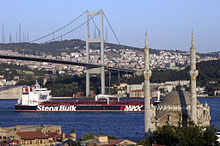
As the only sea route between the oil-rich Black Sea and the Mediterranean, the Bosphorus is one of the busiest waterways in the world; more than 200 million tonnes of oil pass through the strait each year, and the traffic on the Bosphorus is three times that on the Suez Canal. As a result, there have been proposals to build a canal, known as Canal Istanbul, parallel to the strait, on the European side of the city. Istanbul has three major shipping ports—the Port of Haydarpaşa, the Port of Ambarlı, and the Port of Zeytinburnu—as well as several smaller ports and oil terminals along the Bosphorus and the Sea of Marmara. Haydarpaşa, situated at the southeastern end of the Bosphorus, was Istanbul's largest port until the early 2000s. Shifts in operations to Ambarlı since then have left Haydarpaşa running under capacity and with plans to decommission the port. As of 2007, Ambarlı, on the western edge of the urban centre, had an annual capacity of 1.5 million TEUs (compared to 354,000 TEUs at Haydarpaşa), making it the fourth-largest cargo terminal in the Mediterranean basin. The Port of Zeytinburnu is advantaged by its proximity to motorways and Atatürk International Airport, and long-term plans for the city call for greater connectivity between all terminals and the road and rail networks.
Istanbul is an increasingly popular tourist destination; whereas just 2.4 million foreigners visited the city in 2000, it welcomed 7 million foreign tourists in 2010, making it the world's tenth-most visited city. Istanbul is Turkey's second-largest international gateway, after Antalya, receiving a quarter of the nation's foreign tourists. Istanbul's tourist industry is concentrated in the European side, with 90 percent of the city's hotels located there. Low- and mid-range hotels tend to be located on the Sarayburnu, while higher-end hotels are primarily located in the entertainment and financial centers north of the Golden Horn. Istanbul's seventy museums, the most visited of which are the Topkapı Palace Museum and the Hagia Sophia, bring in $30 million in revenue each year. The city's environmental master plan also notes that there are 17 palaces, 64 mosques, and 49 churches of historical significance in Istanbul.
Culture
Istanbul was historically known as a cultural hub, but its cultural scene stagnated after the Turkish Republic shifted its focus toward Ankara. The new national government established programs that served to orient Turks toward musical traditions, especially those originating in Europe, but musical institutions and visits by foreign classical artists were primarily centered in the new capital. Although much of Turkey's cultural scene had its roots in Istanbul, it was not until the 1980s and 1990s that Istanbul reemerged globally as a city whose cultural significance is not solely based on its past glory.
By the end of the 19th century, Istanbul had established itself as a regional artistic centre, with Turkish, European, and Middle Eastern artists flocking to the city. Despite efforts to make Ankara Turkey's cultural heart, Istanbul had the country's primary institution of art until the 1970s. Furthermore, when additional universities and art journals were founded in Istanbul during the 1980s, artists formerly based in Ankara moved in. Beyoğlu has been transformed into the artistic centre of the city, with young artists and older Turkish artists formerly residing abroad finding footing there. Modern art museums, including İstanbul Modern, the Pera Museum, Sakıp Sabancı Museum and SantralIstanbul, opened in the 2000s to complement the exhibition spaces and auction houses that have already contributed to the cosmopolitan nature of the city. Still, these museums have yet to attain the popularity of older museums on the historic peninsula, including the Istanbul Archaeology Museums, which ushered in the era of modern museums in Turkey, and the Turkish and Islamic Arts Museum.
The first film screening in Turkey was at Yıldız Palace in 1896, just a year after the technology publicly debuted in Paris. Movie theaters rapidly cropped up in Beyoğlu, with the greatest concentration of theaters being along the street now known as İstiklal Avenue. Istanbul also became the heart of Turkey's nascent film industry, although Turkish films were not consistently developed until the 1950s. Since then, Istanbul has been the most popular location to film Turkish dramas and comedies. While the Turkish film industry ramped up in the second half of the century, it was not until Uzak (2002) and My Father and My Son (2005), both filmed in Istanbul, that the nation's movies began to see substantial international success. Istanbul and its picturesque skyline have also served as a backdrop for a number of foreign films, including Topkapi (1964), The World Is Not Enough (1999), and Mission Istaanbul (2008).
Coinciding with this cultural reemergence was the establishment of the Istanbul Festival, which began showcasing a variety of art from Turkey and around the world in 1973. From this flagship festival came the International Istanbul Film Festival and the Istanbul International Jazz Festival in the early 1980s. With its focus now solely on music and dance, the Istanbul Festival has been known as the Istanbul International Music Festival since 1994. The most prominent of the festivals that evolved from the original Istanbul Festival is the Istanbul Biennial, held every two years since 1987. While its early incarnations were aimed at showcasing Turkish visual art, it has since opened to international artists and risen in prestige to become among the elite biennales, alongside the Venice Biennale and the São Paulo Art Biennial.
Leisure and entertainment
Istanbul has numerous shopping centers, from the historic to the modern. The Grand Bazaar, in operation since 1461, is among the world's oldest and largest covered markets. Mahmutpasha Bazaar is an open-air market extending between the Grand Bazaar and the Egyptian Bazaar, which has been Istanbul's major spice market since 1660. Galleria Ataköy ushered in the age of modern shopping malls in Turkey when it opened in 1987. Since then, malls have become major shopping centers outside the historic peninsula. Akmerkez was awarded the titles of "Europe's best" and "World's best" shopping mall by the International Council of Shopping Centers in 1995 and 1996; Istanbul Cevahir has been among the continent's largest since opening in 2005; while Kanyon won the Cityscape Architectural Review Award in the Commercial Built category in 2006. Abdi İpekçi Street in Nişantaşı and Bağdat Avenue on the Anatolian side of the city have evolved into high-end shopping districts.
Aside from typical Turkish cuisine like kebab, Istanbul is also famous for its historic seafood restaurants. Many of the city's most popular and upscale seafood restaurants line the shores of the Bosphorus, while the Kumkapı neighbourhood along the Sea of Marmara has a pedestrian zone that hosts around fifty fish restaurants. The Princes' Islands, 15 kilometers (9 mi) from the city centre, are also popular for their seafood restaurants. Because of their restaurants, historic summer mansions, and tranquil, car-free streets, the Princes' Islands are a popular vacation destination among Istanbulites and foreign tourists.
Restaurants featuring foreign cuisines are mainly concentrated in the Beyoğlu district. Residing along İstiklal Avenue is the Çiçek Pasajı, now home to winehouses (known as meyhanes), pubs, and restaurants. While the focus of İstiklal Avenue, originally famous for its taverns, has shifted toward shopping, the nearby Nevizade Street is still lined with winehouses and pubs. Some other neighborhoods around İstiklal Avenue have recently been revamped to cater to Beyoğlu's nightlife, with formerly commercial streets now lined with pubs, cafés, and restaurants playing live music. Other focal points for Istanbul's nightlife include Nişantaşı, Ortaköy, Bebek, and Kadıköy.
Sports
Istanbul has some of Turkey's oldest sports clubs. Beşiktaş J.K., established in 1903, is considered the oldest of these sports clubs; because of its initial status as Turkey's only club, it occasionally played as the national team. While its football team has seen several periods of dominance in national competition, Istanbul's Galatasaray S.K. and Fenerbahçe S.K. have fared better in international competition and tie for the honour of winning the most Süper Lig championships. Galatasaray and Fenerbahçe have a long-standing rivalry across the Bosphorus, with Galatasaray based in European Istanbul and Fenerbahçe based in the Anatolian part of the city. Istanbul has four basketball teams— Anadolu Efes S.K., Beşiktaş, Fenerbahçe Ülker, and Galatasaray Medical Park—that play in the premier-level Turkish Basketball League.
Many of Istanbul's sports facilities have been built or upgraded since 2000 to bolster the city's bids for the Summer Olympic Games. Atatürk Olympic Stadium, the largest multi-purpose stadium in Turkey, was completed in 2002 as an IAAF first-class venue for track and field. The stadium hosted the 2005 UEFA Champions League Final and remains the home field of İstanbul Büyükşehir Belediyespor. Şükrü Saracoğlu Stadium, Fenerbahçe's home field, hosted the 2009 UEFA Cup Final three years after its completion, and Türk Telekom Arena opened in 2011 to replace Ali Sami Yen Stadium as Galatasaray's home turf. All three stadiums are elite Category 4 (formerly five-star) UEFA stadiums.
The Sinan Erdem Dome, among the largest indoor arenas in Europe, hosted the final of the 2010 FIBA World Championship, the 2012 IAAF World Indoor Championships, and the 2011–12 Euroleague Final Four. Prior to the completion of the Sinan Erdem Dome in 2010, Abdi İpekçi Arena was Istanbul's primary indoor arena, having hosted the finals of EuroBasket 2001. Several other indoor arenas, including the Beşiktaş Akatlar Arena, have also been inaugurated since 2000, serving as the home courts of Istanbul's sports clubs. The most recent of these is the 13,800-seat Ülker Sports Arena, which opened in 2012 as the home court of Fenerbahçe's basketball teams. Despite the construction boom, four consecutive bids for the Summer Olympics—in 2000, 2004, 2008, and 2012—and national bids for UEFA Euro 2012 and UEFA Euro 2016 have ended unsuccessfully. Istanbul is currently bidding for the 2020 Summer Olympics. The host city will be announced on 7 September 2013.
Istanbul Park was a stop on the World Touring Car Championship circuit and the European Le Mans Series in 2005 and 2006, but the track has not seen either of these competitions since then. Between its opening in 2005 and 2011, Istanbul Park also hosted the annual Turkish Grand Prix; its future remains uncertain due to financial troubles. The Istanbul Sailing Club, established in 1952, hosts a number of races, showcases, and events on the waterways in and around Istanbul each year. The Turkish Offshore Racing Club also hosts major races, with its most prestigious being its race for the Marine Forces Trophy. Istanbul was also an occasional stop on the F1 Powerboat World Championship circuit, although its last appearance on the Bosphorus was in 2000.
Education
Istanbul University, founded in 1453, is the oldest Turkish educational institution in the city. Although originally an Islamic school, the university established law, medicine, and science departments in the 19th century and was secularized after the founding of the Turkish Republic. Istanbul Technical University, founded in 1773 as the Royal School of Naval Engineering, is the world's third-oldest university dedicated entirely to engineering sciences. These public universities are two of just eight across the city; other prominent state universities in Istanbul include the Mimar Sinan Fine Arts University, which served as Turkey's primary institution of art until the 1970s, and Marmara University, the country's third-largest institution of higher learning. Istanbul Medeniyet University, founded in 2010, is the newest public university, offering two-year degrees through eleven academic departments.
While the most established universities in Istanbul are backed by the government, the city has a number of prominent private institutions. The first modern private university in Istanbul was Robert College, founded by a group from the United States in 1863. The tertiary element of its education program has become the public Boğaziçi University in 1971, while the remaining portion in Arnavutköy continues as a boarding school under the name Robert College. Private universities were officially outlawed in Turkey before the Constitution of 1982, but there were already fifteen private "higher schools", which were effectively universities, in Istanbul by 1970. The first private university established in Istanbul since 1982 was Koç University (founded in 1992), and another dozen had opened within the following decade. Today, there are at least thirty private universities in the city, including Istanbul Commerce University and Kadir Has University.
In 2007, there were about 4,350 schools, about half of which were primary schools; on average, each school had 688 students. In recent years, Istanbul's educational system has expanded substantially; from 2000 to 2007, the number of classrooms and teachers nearly doubled and the number of students increased by more than 60 percent. Galatasaray High School, established in 1481 as the Galata Palace Imperial School, is the oldest high school in Istanbul and the second-oldest educational institution in the city. It was built at the behest of Sultan Bayezid II, who sought to bring students with diverse backgrounds together as a means of further strengthening his growing empire. It is one of Turkey's Anatolian High Schools, elite public high schools that place a stronger emphasis on instruction in foreign languages. Galatasaray, for example, offers instruction in French, while other Anatolian High Schools primarily teach in English or German alongside Turkish. The city also has foreign high schools, such as Liceo Italiano, that were established in the 19th century to educate foreigners.
A few of Istanbul's other high schools are notable for their styles of teaching or entrance requirements. Kuleli Military High School, located along the shores of the Bosphorus in Çengelköy, and Turkish Naval High School, located on one of the Princes' Islands, are military high schools, complemented by three military academies—the Turkish Air Force, Turkish Military, and Turkish Naval Academies. Another important school in Istanbul is Darüşşafaka High School, which provides free education to children across the country missing at least one parent. Darüşşafaka begins instruction with the fourth grade, providing instruction in English and, starting in sixth grade, a second foreign language—German or French. Other prominent high schools in the city include Kabataş Erkek Lisesi (founded in 1908) and Kadıköy Anadolu Lisesi (founded in 1955).
Public services
Istanbul's first water supply systems date back to the city's early history, when aqueducts (such as the Valens Aqueduct) deposited the water in the city's numerous cisterns. At the behest of Suleiman the Magnificent, the Kırkçeşme water supply network was constructed; by 1563, the network provided 4,200 cubic meters (150,000 cu ft) of water to 158 sites each day. In later years, with the aim of responding to the ever-increasing public demand, water from various springs was channeled to public fountains, like the Fountain of Ahmed III, by means of supply lines. Today, Istanbul has a chlorinated and filtered water supply and a sewage treatment system managed by the Istanbul Water and Sewerage Administration (İSKİ).
The Silahtarağa Power Station, a coal-fired power plant along the Golden Horn, was the sole source of Istanbul's electricity between 1914, when its first engine room was completed, and 1952. Following the founding of the Turkish Republic, the plant underwent a number of renovations to accommodate the city's increasing demand; its capacity grew from 23 megawatts in 1923 to a peak of 120 megawatts in 1956. Capacity proceeded to decline until the Silahtarağa Power Station reached the end of its economic life and shut down in 1983. The state-run Turkish Electrical Authority (TEK) briefly—between its founding in 1970 and 1984—held a monopoly on the generation and distribution of electricity, but now the authority—since split between the Turkish Electricity Generation Transmission Company (TEAŞ) and the Turkish Electricity Distribution Company (TEDAŞ)—competes with private electric utilities.
The Ottoman Ministry of Post and Telegraph was established in 1840 and the first post office, the Imperial Post Office, opened near the courtyard of Yeni Mosque. By 1876, the first international mailing network between Istanbul and the lands beyond the vast Ottoman Empire had been established. Sultan Abdülmecid I issued Samuel Morse his first official honour for the telegraph in 1847, and construction of the first telegraph line—between Istanbul and Edirne—finished in time to announce the end of the Crimean War in 1856. A nascent telephone circuit began to emerge in Istanbul in 1881 and after the first manual telephone exchange became operational in Istanbul in 1909, the Ministry of Post and Telegraph became the Ministry of Post, Telegraph, and Telephone. Of course, Istanbul's telecommunications infrastructure has developed substantially in the century since. GSM cellular networks arrived in Turkey in 1994, with Istanbul among the first cities to receive the service. Today, mobile and landline service is provided by a number of private companies, after Türk Telekom, which split from the Ministry of Post, Telegraph, and Telephone in 1995, was privatized in 2005. Postal services remain under the purview of what is now the Post and Telegraph Organization (retaining the acronym PTT).
In 2000, Istanbul had 137 hospitals, of which 100 were private. Turkish citizens are entitled to subsidized healthcare in the nation's state-run hospitals. As public hospitals tend to be overcrowded or otherwise slow, private hospitals are preferable for those who can afford them. Their prevalence has increased significantly over the last decade, as the percentage of outpatients using private hospitals increased from 6 percent to 23 percent between 2005 and 2009. Many of these private hospitals, as well as some of the public hospitals, are equipped with high-tech equipment, including MRI machines, or associated with medical research centers. Turkey has more hospitals accredited by the U.S.-based Joint Commission than any other country in the world, with most concentrated in its big cities. The high quality of healthcare, especially in private hospitals, has contributed to a recent upsurge in medical tourism to Turkey (with a 40 percent increase between 2007 and 2008 alone). Laser eye surgery is particularly common among medical tourists, as Turkey is known for specializing in the procedure.
Transportation
Istanbul's primary motorways are the O-1, O-2, O-3, and O-4. The O-1 forms the city's inner ring road, traversing the Bosphorus Bridge, and the O-2 is the city's outer ring road, crossing the Fatih Sultan Mehmet (Second Bosphorus) Bridge. The O-2 continues west to Edirne and the O-4 continues east to Ankara; the O-2, O-3, and O-4 are coterminous with European route E80 (the Trans European Motorway) between Portugal and the Turkish–Iranian border. The two Bosphorus Bridges currently form the only fixed links between the Asian and European sides of Turkey, together carrying 400,000 vehicles each day. The dual-deck, 14.6-kilometer (9.1 mi) Eurasia Tunnel is currently under construction beneath the Bosphorus, between Kumkapı, Fatih and Selimiye, Üsküdar. The Third Bosphorus Bridge, first considered in the 1990s, may also finally be coming to fruition, as the project was officially launched in 2012. Both projects may be completed as early as 2015.
Istanbul's local public transportation system is a complex network of trams, funiculars, metro lines, buses, bus rapid transit, and ferries. Fares across modes are integrated, using the contactless Istanbulkart, introduced in 2010, or the older Akbil electronic ticket device. Trams in Istanbul date back to 1872, when they were horse-drawn, but even the first electrified trams were decommissioned in the 1960s. Operated by Istanbul Electricity, Tramway, and Tunnel (İETT), trams slowly returned to the city in the 1990s with the introduction of a nostalgic route and a faster modern tram line, which now carries 265,000 passengers each day. The Tünel opened in 1875 as the world's second-oldest subterranean rail line (after London's Metropolitan Railway). It still carries passengers between Karaköy and İstiklal Avenue along a steep 573-meter (1,880 ft) track, while a more modern funicular between Taksim Square and Kabataş began running in 2006. The Istanbul Metro comprises three disconnected lines (the M1, M2, and M4) with several other lines (including the M3) and extensions under construction or proposed.
The two sides of Istanbul's metro will ultimately be connected under the Bosphorus when the Marmaray tunnel, the first rail connection of any kind between Thrace and Anatolia, is completed in 2015. Upon its completion, rail use in the city is expected to increase to 28 percent (from just 4 percent), behind only Tokyo and New York City. Until then, buses provide transportation within and between the two halves of the city, accommodating 2.2 million passenger-trips each day. The Metrobus, a form of bus rapid transit, traverses the Bosphorus Bridge, with dedicated lanes leading to its termini. İDO (Istanbul Seabuses) runs a combination of all-passenger ferries and car-and-passenger ferries to ports on both sides of the Bosphorus, as far north as the Black Sea. With additional destinations around the Sea of Marmara, İDO runs the largest municipal ferry operation in the world. The city's main cruise ship terminal is the Port of Istanbul in Karaköy, with a capacity of 10,000 passengers per hour. While most visitors enter Istanbul by air, about half a million foreign tourists enter the city by sea each year.
International rail service from Istanbul launched in 1889, with a line between Bucharest and Istanbul's Sirkeci Terminal, which ultimately became famous as the eastern terminus of the Orient Express from Paris. Regular service to Bucharest and Thessaloniki continued until the early 2010s, when the former was interrupted for Marmaray construction and the latter was halted due to economic woes in Greece. After Istanbul's Haydarpaşa Terminal opened in 1908, it served as the western terminus of the Baghdad Railway and an extension of the Hejaz Railway; today, neither service is offered directly from Istanbul. Service to Ankara and other points across Turkey is normally offered by Turkish State Railways, but construction of Marmaray and the Ankara-Istanbul high-speed line forced the station to close in 2012. New stations to replace both the Haydarpaşa and Sirkeci terminals, and connect the city's disjointed railway networks, are expected to open upon completion of the Marmaray project; until then, Istanbul is left without intercity rail service. Private bus companies instead operate routes along—and well beyond—those offered by the rail network. Istanbul's main bus station is the largest in Europe, with a daily capacity of 15,000 buses and 600,000 passengers, serving destinations as far as Frankfurt.
Istanbul has two international airports, the larger of which is Istanbul Atatürk. Atatürk, located 24 kilometers (15 mi) west of the city centre, handled 45.1 million passengers in 2012, making it the sixth-busiest airport in Europe and the twentieth-busiest in the world. Sabiha Gökçen International, 45 kilometers (28 mi) southeast of the city centre, opened in 2001 to relieve Atatürk. Dominated by low-cost carriers, Istanbul's second airport has rapidly become popular among travellers, especially since inaugurating a new international terminal in 2009; the airport handled 14.7 million passengers in 2012, a year after Airports Council International named it the world's fastest-growing airport. Atatürk has also experienced rapid growth, as its 20.6 percent rise in passenger traffic between 2011 and 2012 was the greatest among the world's top thirty airports. As such, a third airport has been proposed for the Black Sea coast.

